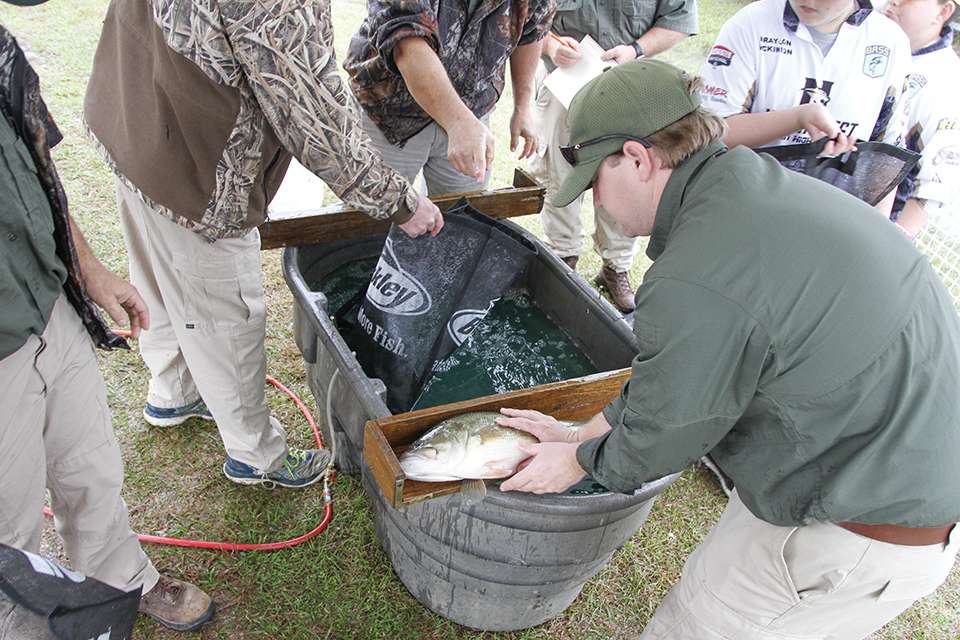
RIDGELAND, Miss. — What do bass tournaments and fisheries management have in common? The answer is a lot when it comes to collecting beneficial scientific data so anglers can catch more and bigger fish.
Collecting scientific data from game fish populations within a lake is important to biologists. They crunch the numbers to determine growth rates, population densities and how angler trends affect management policies.
Gathering that data can be hit and miss. Electrofishing is a common method, but the coverage area is small given the limited time available to capture the fish. Tagging fish is another option, and it is successful when anglers volunteer the information from their catch. Other methods are used, too, and when combined the sum of the whole gives fisheries managers the data needed to make decisions.
Bass tournaments are valuable because of the sheer numbers of fish that can be collected and sampled by biologists. Anglers do the catching for them, and weigh-ins offer one-stop shopping where hundreds of fish can be examined.
“It is an easier way for them to collect scientific data, and we offer that opportunity at just about everywhere we hold tournaments,” said Gene Gilliland, B.A.S.S. conservation director and a fisheries scientist.
Tournaments allow fisheries scientists to even dial into a specific research need, such as whether or not a particular size limit is benefiting the growth and population of a bass population.
That is happening at the Bass Pro Shops Bassmaster Central Open with the Mississippi Department of Wildlife, Fisheries and Parks (MDWFP). Biologists are measuring and collecting other information before the fish are released back into Ross Barnett Reservoir.
Scientists want to know if the current 14-inch minimum size limit for largemouth is helping protect brood fish populations. Keeping those fish in the lake so they can reproduce and make the bass population flourish is the plan. Those fish were susceptible to capture and being kept under the previous 12-inch minimum limit.
“Those 12- and 14-inch fish fall within the two-year age class of what we deem the size of largemouth in Ross Barnett that keep the population growing,” said Ryan Jones, a MDWFP fisheries biologist.
Jones said the central collection point at the weigh-in greatly increases the numbers of fish he needs to grow his database of information.
Another factor that is an asset for Jones is the timing of the Open. Last year he collected bass during the Bassmaster Elite Series held on Ross Barnett. By that April event the spawn was mostly over and collection rates were lower. The spawn is in full swing during the Open, and Jones anticipates getting even greater numbers in size and quantity.
Strong ties have long existed between B.A.S.S. and fisheries agencies and especially through the weigh-in outreaches. The effort is especially beneficial on northern fisheries, where resources are spread out over cold- and warm-water game fish management.
In Wisconsin, B.A.S.S. worked with the Department of Natural Resources to help create a research database useful for evaluating policies. The process got jumpstarted on Sturgeon Bay, site of the 2015 Toyota Bassmaster Angler of the Year Championship.
“They didn’t really have a good process for evaluating the smallmouth population, given the sheer size of the area,” explained Gilliland.
A similar example developed on Lake St. Clair. Tournament anglers traveled through that lake to reach Lake Erie to catch bigger smallmouth. Fisheries managers wanted to know if the presumption of the anglers was true.
“They came to us because anglers were complaining about skinny smallmouth in St. Clair,” said Gilliland. “Nobody understood why so sampling large numbers of fish from our weigh-in was logical.”
Data from those “skinny” fish was analyzed to help fisheries scientists research better ways to manage the population.
“We are pleased to help,” added Gilliland. “Whatever we can do to help our partners is certainly for the good of the sport.”





